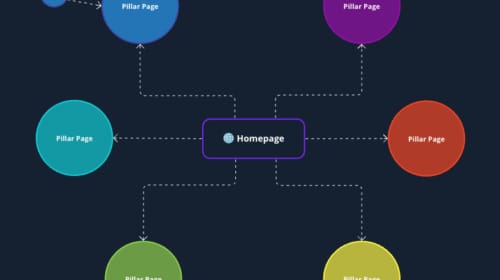Key Takeaways:
- Effective SEO strategy demands meticulous planning, research, and analysis to create a robust content marketing plan.
- Identify keywords with decent search volume and low difficulty scores to outrank competitors and gain visibility in search engines.
- Consider hiring an SEO consultant if overwhelmed, or follow a step-by-step guide to build a data-driven content marketing pipeline.
- Create unique, net-new content pieces, avoiding keyword cannibalization, and plan topics that relate to each other for a cohesive content calendar.
- Structure SEO content for success by addressing user intent, commonly asked questions, and optimizing on-page elements for search engine visibility and user engagement.
Crafting an effective SEO strategy isn’t that simple. It demands planning, research, and analysis. The reward? A robust SEO content marketing strategy that’s truly worth the effort.
In order to outrank your competitors and get visibility in Google’s search engine, it’s essential to find keywords with a decent amount of search volume and a low keyword difficulty score. Then, create high quality content that’s relevant to what your potential new customers are actively searching for. If all of this seems overwhelming, you might want to consider hiring an SEO consultant to help you with your overall SEO strategy.
If you are ready to take a crack at it yourself, follow this step-by-step guide for building a data-driven content marketing pipeline that will rank in search engines for target keywords and bring new customers to your website.
1. Keyword Research and Analysis
Pro tip: Start with finding the right keywords, then create a topic. DO NOT do it the other way around. Content should always start with SEO and keyword research.
Conducting Market Research
The first question want to ask yourself is, “What are people searching for in Google that my product or service offering can solve?”
Search marketers often refer to this as “user intent.” To do this, you will need to understand your customer’s pain points and frequently asked questions. For example, if you sell coffee makers you will want to find frequent questions people ask when looking to buy one. These types of searches are also known as “keyword intent.” There are four different types of keyword intent including informational, navigational, commercial, and transactional.
The next step is to inspect your top competitors’ websites to see what keywords they are ranking for. Check and see what their content marketing strategy is and find some topics and keyword phrases that you could also compete with.
Finally, for the market research portion, cross-reference your website’s current rankings against your competitors to find the keyword gaps and opportunities you should target. From here you can start building your keyword lists to target.
You’ll also want to know what your website’s Domain Authority (DA) is against your competitors’. The Domain Authority is calculated by the number of quality backlinks your site has. You’ll also want to know your competitors’ DA for comparing your website’s “rankability.”
For example, if your DA is 50 and you are looking to rank for the keyword “best coffee maker” and all the DA’s on page one of Google are 60 and above, that keyword will be more difficult for your site to compete and rank for. On the other hand, if your website’s DA is 50 and you find a keyword with DA’s ranking on page one below 55, then you have a good chance at winning or ranking for that keyword.
The short story is, Domain Authority is a major determining factor to whether or not a website can rank for a keyword. The goal is to find a keyword that your website’s DA can compete against and win.
Compile a list on an Excel sheet of all your target keywords from your competitors’ websites. You’ll want to keep a list of your current top-ranking keywords as well for the planning phase. We will get into this more, but the main goal is to write about new content that doesn’t already exist on your site.
Now that you’ve started some initial research, you’re ready to start planning your SEO content strategy. Create two to four topics that all relate to each other but aren’t too similar. The topics ideally need to play off each other in a sort of sequential way. For example, if you’re selling fishing poles and tackle, you’ll want to write about the best kind of poles, then write about the best kind of reels, and next the best types of lures — then, link them all together. This SEO content tactic is known as building a “content topic cluster” or a “hub and spoke” model where you link all your blog topics together. This builds authority on the topic and keeps people interested by taking them naturally through the steps of the buying process.
Related content: Complete SEO Glossary for Beginners
To build your content topic cluster, pick a theme to focus on. Keeping the focus of your content cluster will help with planning and the topics will start to naturally come into view. If you have some topics in mind already, you’ll want to do some keyword research.
What it really comes down to is keyword research. Find keywords with a decent amount of search volume that also have a low keyword difficulty score.
So, what does that mean? Let’s break it down.
Keyword Search Volume:
This is how often people search for this keyword or topic in search engines, mostly Google. Google calls this “average monthly search volume.” They take the frequency of the term’s search throughout the year and come up with a monthly average. Certain keywords are seasonal, like summer type keywords “best grill” or “Fourth of July decorations.” Some keywords are evergreen or good all year long.
To find keywords and search volume, you’ll want to use Google’s Keyword Planner Tool. You can also use other keyword research tools within SEM Rush and Moz, but know they are getting a lot of their information from the same database — Google. Google has a lot of data on search volume and trends, but it can be hard to get the tool to generate more ideas. The keyword planner is my preferred place to start when conducting keyword research.
Keyword Difficulty Score:
This is the most important step when deciding on a final keyword set. This step is the difference between success and failure. This is a score that’s calculated by a couple of different SEO tools.
The number is based on the same data point, which is the following:
- The Domain Authority on Google’s Search Engine Results Page (SERP) for that specific keyword
- The domain authority is calculated by how many quality backlinks a website has from a variety of root domains. Meaning more links from a variety of websites vs. many links from a handful of websites.
- The keyword difficulty score from SEM Rush ranges from 0-100 or Easy to Very Difficult.
- This score is determined by what pages are ranking for a particular keyword and have well optimised, structured content with a number of backlinks. The more optimised SERPs there are, the more difficult it makes to rank your website for that keyword.
The name of the game is to find relevant keywords with a decent amount of search volume (100+ AVM) and have a low to medium difficulty score.
For this particular blog post, the target keyword is “SEO content strategy” with 400 AVM and a keyword difficulty score of “difficult.” This is when we will take a closer look at the SERP and see what DA’s are ranking on page one. Since TEAM LEWIS’ site has a DA of 56, we can leapfrog a site that has a DA lower than 66.
Moz also has a keyword difficulty score and a nice snapshot of the SERP and the DAs that are ranking. Below is a screenshot of Moz’s SERP analysis of the keyword “SEO content strategy.”
You will see positions that are highlighted in green to indicate potential rank positions for the keyword “SEO content strategy.” With a DA of 56, we could potentially rank in positions 5, 6, 7, 9, and 10.


Below is an example of what SEM Rush’s keyword difficulty score and SERP analysis look like.
Note: SEM Rush refers to DA as AS or Authority Score. It’s the same as DA.


2. Building the Content Calendar
Keyword Cannibalisation Check
Before you start planning your content calendar, make sure you don’t have an existing blog that is similar to your new blog because they will compete against each other and potentially work against your SEO and content marketing efforts.
To maximise your SEO efforts, you need to create unique net-new content pieces. This step is critical to the success of your SEO content strategy. To do this, you can download your rankings from SEM Rush and cross-reference what is ranking by either doing a search within your sheet or running a VLOOKUP formula to check at scale. Another way to check is to search your own blog for existing topics. If one already exists but isn’t ranking, you can use that existing content and refresh it with a new outline and optimised structure.
Creating the Content Calendar
Now that you’ve decided on a list of target keywords, it’s time to build some topics or titles around them.
Below is an example of what this might look like.

Consider the content marketing funnel. Some of the best content to plan includes the following:
- Evergreen content topics
- Top-of-the-funnel informational topics (TOFU content)
- Content that aligns with existing downloadable assets, products, or service offerings
Repeat the keyword research and ideation steps to create at least four topics for the month. This is called a “content topic cluster” or a “hub and spoke” model. You’ll want to make sure all the topics relate to each other so you can link them internally and create a nice flow for your users to navigate through.
Related content: Understanding the Types of SEO and the SEO Process
3. Outlining SEO Content for Success
To really knock it out of the park and set yourself up for success, do a little research on your topic to find commonly asked questions around your target keyword. To do this, simply Google the keyword and look for the “People Also Ask” answer box that Google features. These questions indicate a user’s search intent and guide you on your content creation process. Use those questions to create sections and headers based on researching related subtopics.
Follow the inverted pyramid tactic and put all your most important information at the top. Studies have shown that pages appear in Google’s top search results when the keyword is used within the first 100 words. Studies have also shown that content topics that rank higher in Google have an average word count of 1,500-2,000 words. Quality content doesn’t just mean it has to be lengthy — it needs to be considered in-depth on a specific topic.

4. Adding Final On-Page Optimisation Touches
Finally, you’ll want to create an optimised title tag and meta description with your keyword at the front of the title tag. There are many SEO tools out there to use, but the most common tool used in WordPress websites is the Yoast SEO plugin. Once installed, this plugin shows you what your snippet will look like in Google as you compose your title tag and meta description in the SEO tool.
Adding internal links is highly recommended not only for enhancing the user experience but also for improving your websites’ behaviour metrics like pages per visit and time on site, which sends a quality content signal to Google. Using exact-match anchor text also passes page authority through to the page that you’re trying to rank for a target keyword.
For example, the blog post I’m about to link to later in this sentence is all about Understanding the Types of SEO and the SEO Process. When you click through the hyperlink, you are taken to a blog post that’s all about Types of SEO and the SEO process. This is an example of exact-match anchor text internal linking.
Once you’ve got your title tag, meta description, and internal links all situated, you’ll want to consider adding some imagery or video content to your post. Adding a video increases time on site which is a secondary ranking factor Google takes into consideration when analysing quality content. So, if you have the time to create a video to complement your blog content, definitely go for it. Other image ideas to consider would be not just using a stock image but using a creative graphic that might make your reader pause and engage with your webpage.
Once you’ve added your images and video, the next and final step is to make sure you add some schema markup. This is code that lives on the backend of your webpage that Google and other search engines crawl. This helps them see what’s on your page and then show it in the search results as a featured snippet. Featured snippets appear in Google as an image carousel, video results, knowledge panel, answer boxes and much more.
Summary
Creating an effective SEO content strategy requires a combination of keyword research and analysis to create net-new relevant-quality content for the user. Combining all these recommended content marketing strategies and SEO tactics is the best way to build a winning SEO content marketing campaign.
Keen to power up your performance marketing? Sign up for our complimentary SEO or website audit. Check out our performance marketing services here.



